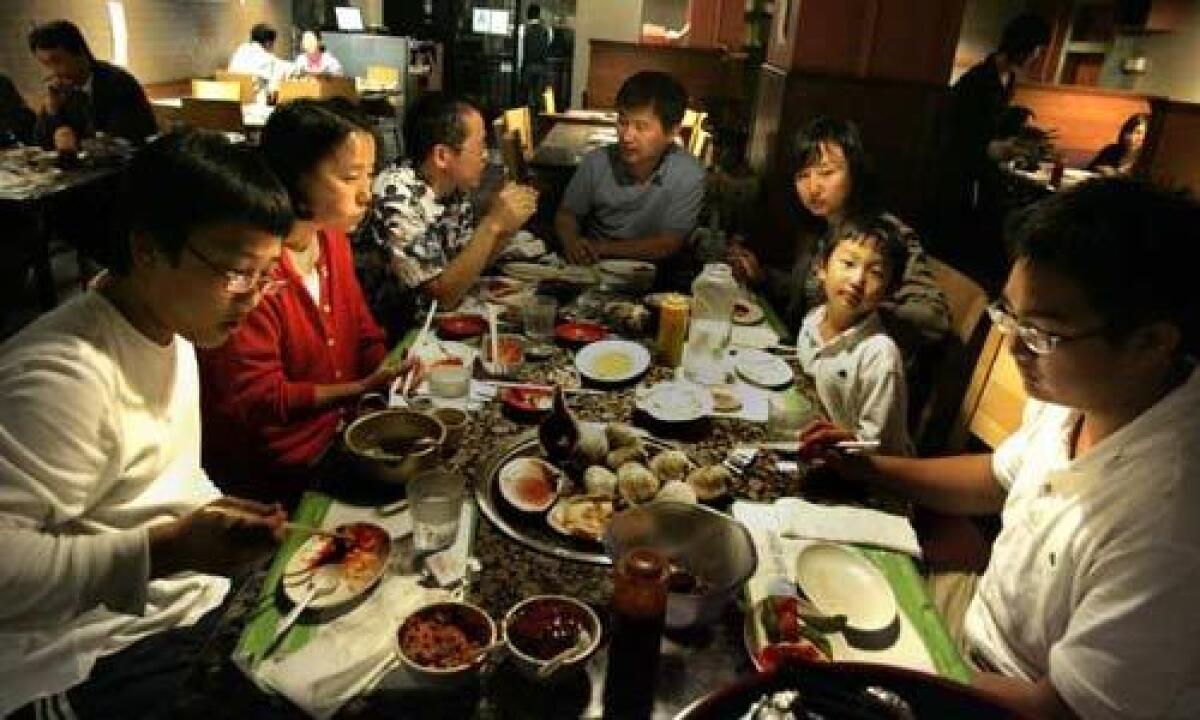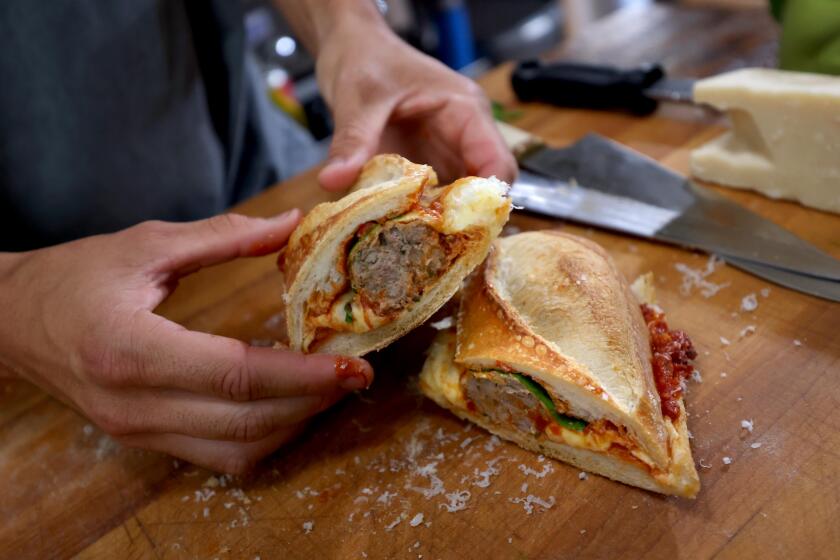The Find: Flaming Clam Grill of Cheongdamdong in Koreatown

The new Flaming Clam Grill in the Chapman Market complex is the first restaurant in Koreatown to devote itself exclusively to multi-course all-seafood repasts.
Inspired by Seoul’s food craze of the moment, grilled shellfish courses are showing up all over K-town as a sideline to the meats. But here, shimmering mounds of unshelled oysters, conch, shrimp, abalone, scallops, several clam varieties and more grace every table. The servers grill these in front of you in a predetermined sequence, ceremoniously shelling and cutting them for easy consumption. It’s a hedonistic clambake, Korean style.
The restaurant’s name, Bultaneun Cheongdamdong Jogae Gui, translates into English as “Flaming Clam Grill of Cheongdamdong,” an image that may conjure an otherworldly deity. But Cheongdamdong, a posh Seoul suburb nicknamed the Korean Beverly Hills and known for designer boutiques and art galleries, was more likely chosen to confer the restaurant and fashionable Chapman Market with the same caché.
In the dining room, stunning high-key photographs of shellfish composed as postmodern still lifes contrast with the rustic granite tables and wood plank floors. It’s a 21st century take on the funky traditional seafood specialty shacks that line South Korea’s coastline. At those places, as here, diners linger and meals go on for hours, progressing from clams to squid to mussel soup and beyond, all enhanced by plenty of soju or beer.
For starters
Banchan, the small plates of appetizers, start off the meal while the grill heats. They’re not the usual assortment of marinated vegetables. The lineup includes pale blue speckled quail eggs in their shells, tiny bowls of abalone-scented rice porridge and a communal plate of spicy stir-fried udon flecked with shellfish bits. Vegetable pancake, potato tempura and other goodies seem to leave little table space for the main events -- but they always get squeezed in somehow. Restraint is in order, though; there’ll be lots more to eat.
The first round of clams hits the grill and soon after they open the server is right there to scoop them from their shells, quarter them with her sharp scissors and pour their briny liquid into the bowl of clear mussel broth that arrived with the banchan. With the clam juice added, the broth’s taste is marine umami times 10 and the clam bites spurt juice as you chew. The absence of kimchi may surprise Koreaphiles, but its powerful flavor would overwhelm the shellfish.
Do explore the little bowls of house-made salsa, the sweet mayonnaise-like sauce and the tart and sweet hot sauces in squeeze bottles that add interest to plainer-tasting items.
The server returns again and again to tend to the grill and begin cooking yet another round of shellfish. Included are scallops with their beautiful coral still in the shells, a majestic-looking conch and chunks of giant geoduck clam (mirugai) laid into empty scallop shells.
When the house is packed and the waitstaff is stretched a little thin, the grilling seafood easily overcooks. In that case it’s best to borrow the tongs on the table and move the mollusks to the side of the grill when they’re ready. Shrimp, which is cooked wrapped in foil packets, steams rather than grills. They’re tastier if you request them cooked directly over the flame without the foil.
And finally . . .
For the final course, a huge pot of khal gooksoo (knife-cut noodles) in a light, soothing broth replaces the grill. Then and only then does kimchi make an appearance to spice it up.
Flaming Clam lacks a menu written in English, but even without Korean-speaking friends, there’s no problem ordering. The single-page photo-illustrated document offers three nearly identical communal meals: The $39.99 version serves two or three, the $59.99, four or five.
The $99.99 for six to eight gives the most variety, including three small abalone roasted with sesame oil. A la carte items shown on the flip side of the menu can augment the dinners to accommodate an uneven number of guests.
On weekends the restaurant gets crowded, so it’s best to reserve by calling ahead during the evening hours when a few members of the English-speaking staff are on duty. Then settle in, take an imaginary journey to Cheongdamdong, for a seafood phenomenon that’s entirely real.
More to Read
Eat your way across L.A.
Get our weekly Tasting Notes newsletter for reviews, news and more.
You may occasionally receive promotional content from the Los Angeles Times.









